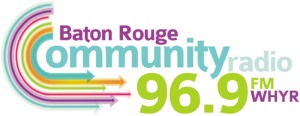You can record and prepare shows at home with a personal computer and software such as Audacity or Garage Band. To record your voice, you might have limited success using a built-in microphone, but for better results, plug in an external USB microphone. Some battery-powered “portable recorders” can also act as USB-based microphones.
Some rules of thumb:
- Sound can be digitized at various rates and various bit depths. Although high-end digital recording studio equipment might run at say 96,000 Hz and 48 bits, compact discs run at 44,100 Hz and 16 bits. At WHYR we do everything at “compact disc quality”. In other words, we have everything set to 44,100 Hz and 16 bits. You will eliminate unnecessary conversions by setting your own recording and editing equipment to 44,100 Hz and 16 bits.
- Use the highest quality audio available to you. When you rip music off CDs, do so at the “raw” or “lossless” level (which generally means WAV, FLAC, or AIFF files), or in a high-quality lossy format (e.g., 320kbps MP3). Software like iTunes and Windows Media Player defaults to a proprietary format and defaults to a low bit rate. Change the settings before using those programs! Although the audio in WAV files is better than the audio in MP3 files, the latter have the advantage of storing artist and title information. Thus, you might prefer working with 320kbps MP3 over working with WAV.
- Be aware that there can be volume inconsistencies between audio tracks, especially when coming off different CDs (which are all mastered at different volumes). Ripped tracks will be inconsistent. And your own voice volume will depend on various settings (microphone gain and recording level), as well as microphone position and how you speak. As you combine your music and vocal audio in an editing program, normalize each piece of audio to a consistent volume level. This is more an art than a science, so listen with headphones and adjust until it sounds great.
- After combining your normalized raw audio in an audio editor, and adding appropriate fade-ins and fade-outs and other effects to achieve the desired end product, always save out a final “project file”. That’s the cleanest version of your show, something you can go back and open and make changes without incurring any loss of audio data. (Whereas if you export an MP3 and later re-open it, and then try to make changes, you’ll have introduced some quality loss.)
- Your audio editor probably also lets you export (or “bounce down”) the audio in a smaller lossy format, such as MP3, to give you a smaller file for posting on webpages, passing around by e-mail, submitting to us, and so on. But if you later re-open that same MP3 in the audio editor to make changes, you’ll introduce unwanted loss.
- For submitting shows to us, we prefer a 320kbps MP3. Tell your audio editing software to “export” or “bounce down”, being sure to check the settings so that you’ll end up with a 320kbps MP3.
Summary:
- Do everything at 44,100 Hz and 16-bit stereo.
- Store ripped music and intermediate files in a lossless format (e.g., WAV, FLAC, or AIFF) or a high quality lossy format (e.g., 320kbps MP3 is significantly better than 64kbps MP3).
- Normalize the volume on the individual pieces of audio as you mix them together in an audio editor.
- To allow the possibility of going back to do more editing in the future, always keep a lossless copy (“project file”).
- Export a high-quality lossy copy (e.g., 320kbps MP3) for submitting your material to us.


